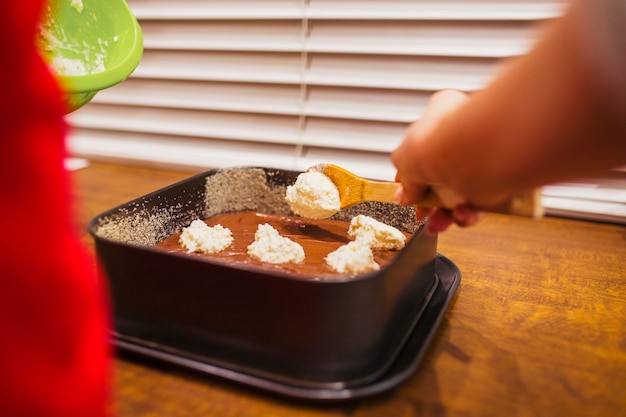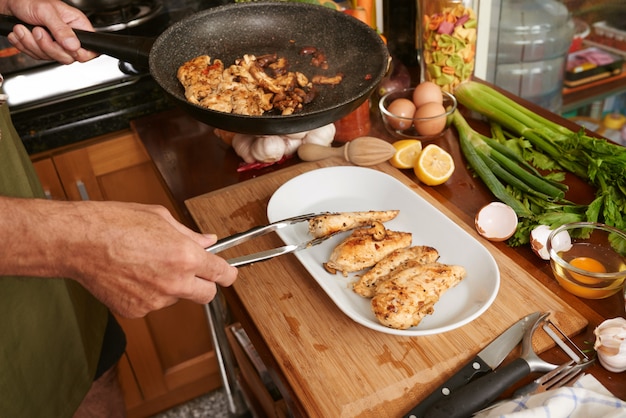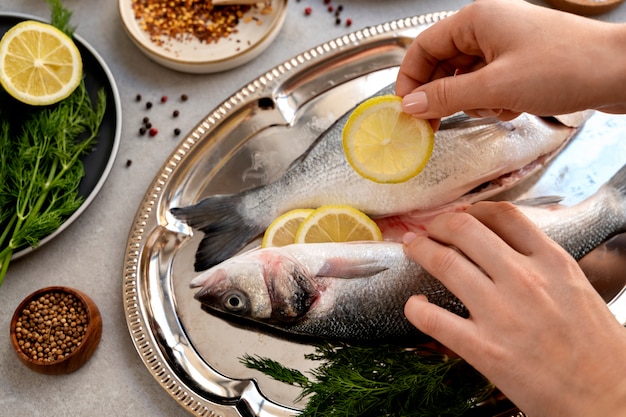(Part 1) The Essential Ingredients: Building Your Seafood Boil Foundation

What Goes in the Pot?
A seafood boil is all about versatility. You can go wild with ingredients, but some core elements form the foundation of any good boil.
- Seafood: This is the star of the show! You can opt for the classics like shrimp, crab legs, and mussels, or get creative with lobster, clams, or even fish fillets. The fresher your seafood, the better the flavour.
- Broth: This is the flavour base. A simple combination of water, salt, and pepper works wonders, but why not elevate things? You can add beer, white wine, a squeeze of lemon juice, or even a splash of Worcestershire sauce to give your broth an extra kick.
- Seasonings: This is where you get to personalize your boil. old bay seasoning is a classic, but don't be afraid to experiment! Paprika, garlic powder, onion powder, cayenne pepper, and black pepper are all great additions. You can even add a touch of smoked paprika or a bay leaf for a hint of complexity.
- Vegetables: Adding vegetables adds texture and freshness. Potatoes, corn on the cob, onions, carrots, and sausage are all popular choices. For a tangy twist, throw in some sliced lemons or limes.
Choosing Your Seafood: The Stars of the Show
The type of seafood you choose will significantly impact the flavour and overall experience. Here’s a breakdown of some popular choices and tips for selecting them:
- Shrimp: A classic, shrimp adds a delicate sweetness. Opt for large shrimp for a more satisfying bite. Look for shrimp that are firm, have a fresh, slightly sweet smell, and are free of discoloration or bruising.
- Crab Legs: Crab legs offer a delightful sweetness and meaty texture. Snow crab or king crab are luxurious choices, while blue crab legs are a budget-friendly alternative. Ensure the crab legs are fresh, with a slight ocean smell, and that the shells are still moist. Avoid any legs that are discoloured or have a strong ammonia smell.
- Mussels: Mussels pack a punch of flavour and a briny taste. Choose mussels that are tightly closed and free from any cracks or damage. Discard any open mussels or those that smell foul.
- Lobster: A luxurious addition, lobster offers a rich, delicate flavour. For the whole experience, opt for a live lobster and cook it whole. Look for a lobster that is active, has a fresh, slightly sweet smell, and has hard, unbroken shells.
Remember, the key is to choose seafood that is fresh, high quality, and appropriate for the size of your pot.
(Part 2) Preparing Your Feast: Prepping for Seafood Boil Success

Prepping the Ingredients: A Cook’s Checklist
Now that you’ve gathered your ingredients, it’s time to get your hands dirty. Here’s how to prep them like a pro:
- Seafood: Rinse your seafood thoroughly under cold water. For whole lobster, give it a good scrub with a brush. For shrimp, you can leave the shells on for a more intense flavour or peel them off for a cleaner presentation.
- Vegetables: Wash and chop your vegetables into bite-sized pieces. For corn on the cob, you can leave it whole or cut it into smaller sections. Cut potatoes into chunks to ensure they cook evenly.
- Broth: Get your broth simmering! Add your water, salt, and any other spices or seasonings. I like to add a bay leaf and a few peppercorns for extra depth.
The Art of Layering: Building Your Seafood Boil Masterpiece
Now comes the fun part – building your seafood boil masterpiece. Here’s my tried-and-true layering technique:
- Start with the broth: Pour your simmering broth into your pot.
- Add the vegetables: Add your potatoes and any other vegetables that take longer to cook. This will give them time to soften up before the seafood goes in.
- In with the sausage: If you're adding sausage, this is the time to toss it in. It’ll add a smoky, savory flavour to the boil.
- The seafood stars: Now comes the main event! Add your crab legs, mussels, and shrimp, making sure they're submerged in the broth. If you're adding lobster, you can lay it on top of the other seafood.
- Season to taste: Sprinkle your favourite seasonings over the seafood. I like to use a generous amount of Old Bay seasoning for that classic seafood boil flavour.
Remember, there's no one right way to layer your seafood boil. Experiment with different combinations and find what works best for you. The key is to ensure all the ingredients are submerged in the broth and have enough space to cook evenly.
(Part 3) The Grand Cook-Off: Cooking Your Seafood Boil to Perfection

Bringing it to a Boil: The First Stage of Cooking
Now for the moment of truth: cooking your seafood boil!
- Cover and heat: Bring your pot to a rolling boil over high heat. This will ensure the seafood cooks quickly and evenly.
- Reduce heat: Once the boil is going strong, reduce the heat to a simmer. This will help to prevent the seafood from overcooking and becoming rubbery.
- cooking time: Cook the seafood for about 5-8 minutes, or until the shrimp are pink and the crab legs are bright red. If you're cooking lobster, it will take about 10-15 minutes depending on its size.
The Test of Doneness: Knowing When Your Seafood is Ready
How do you know your seafood is ready? Here are a few telltale signs:
- Shrimp: The shrimp should be firm and opaque, with a bright pink colour.
- Crab legs: The crab legs should be bright red and the meat should be easily pulled away from the shell.
- Mussels: The mussels should be open and the shells should be easily pulled apart.
- Lobster: The lobster should be bright red and the meat should be firm and white.
If you're not sure if the seafood is cooked through, you can always test it with a fork or a knife. The meat should be tender and cooked through.
(Part 4) Time to Feast! Serving and Enjoying Your Seafood Boil
Serving Up Your Creation: A Feast for the Senses
Now that your seafood boil is cooked to perfection, it’s time to serve it up!
- Drain the pot: Use a strainer or a slotted spoon to remove the seafood and vegetables from the pot.
- Presentation is key: Spread out the seafood and vegetables on a large platter or in individual bowls. For a more rustic look, you can serve them directly from the pot.
- Don't forget the broth: The broth is packed with flavour, so don't forget to serve it alongside the seafood.
- Condiments and extras: Offer a variety of condiments for your guests to enjoy, such as melted butter, cocktail sauce, lemon wedges, and hot sauce.
The Feasting Ritual: Embracing the Seafood Boil Experience
Now, this is where the fun really begins! Here's how to enjoy a seafood boil like a pro:
- Grab your tools: Arm yourself with a crab cracker, a pair of seafood picks, and a bib (trust me, you'll need it!).
- Dig in!: Start by cracking open your crab legs and extracting the delicious meat. Then, pull the shrimp from their shells and enjoy the succulent flesh. Don't forget to savour those sweet, juicy mussels!
- Broth dipping: The broth is your secret weapon. Soak up all those flavours by dipping your seafood, potatoes, and corn on the cob into it.
- Sharing is caring: Seafood boils are all about sharing and enjoying good company. So, grab your friends and family and make a night of it.
(Part 5) Mastering the Flavour Profile: Exploring Seasoning Options
The Essence of Old Bay: A Classic Seafood Boil Staple
Let's talk about Old Bay. It's a staple for any seafood boil, and for good reason. It's a blend of spices that creates a perfectly balanced flavour profile. But what exactly is in this magical mix?
- Celery Salt: This gives Old Bay its signature herbaceous flavour.
- Paprika: Adds a touch of warmth and colour to the blend.
- Black Pepper: Provides a bit of spice and depth.
- Mustard: Adds a tangy note that complements the other spices.
- Red Pepper: Offers a subtle heat.
- Garlic Powder: Enhances the overall savouriness of the blend.
- Others: Old Bay also includes a blend of other spices, such as cloves, allspice, and thyme.
Beyond Old Bay: Spice Up Your Life with Creative Seasonings
While Old Bay is a classic, don't be afraid to get creative with your seasonings. Here are some ideas to spice things up:
- Cajun Seasoning: This will give your seafood boil a fiery kick.
- Lemon Pepper: Adds a bright, citrusy flavour.
- Garlic Herb Blend: Enhances the natural flavour of the seafood with fresh herbs.
- Smoked Paprika: Adds a smoky depth to the boil.
- Chili Powder: For a touch of heat and smokiness.
- Curry Powder: For a flavourful and exotic twist.
Experiment with different combinations and find your own signature spice blend. You can even create your own mix using a combination of fresh and dried herbs and spices. The possibilities are endless!
(Part 6) Pro Tips for Seafood Boil Success: Key Tips for a Perfect Boil
The Bigger the Pot, the Better: Choosing the Right Cooking Vessel
When it comes to seafood boils, size matters. You want a pot that's large enough to accommodate all your ingredients with plenty of room to spare.
- dutch oven: A classic choice for seafood boils. It's heavy-duty and can withstand high heat.
- Stockpot: If you're expecting a large crowd, a stockpot is a great option. It's spacious and perfect for big batches.
- pressure cooker: If you want to cook your seafood boil quickly and easily, a pressure cooker is a great choice. It will reduce the cooking time significantly.
Don't Overcrowd the Pot: Ensuring Even Cooking
It's tempting to cram as much seafood as possible into your pot, but avoid the temptation! Overcrowding the pot will prevent the seafood from cooking evenly and could result in mushy, overcooked seafood.
- Space is key: Make sure there's enough space between the ingredients to allow the heat to circulate evenly.
- Multiple batches: If you have a lot of seafood, it's better to cook it in multiple batches. This will ensure that every piece is cooked to perfection.
Keep an Eye on the Timing: Mastering the Art of Seafood Timing
Overcooking is the enemy of a good seafood boil! Overcooked shrimp will become rubbery, crab legs will lose their tenderness, and mussels will become tough.
- Start checking early: Start checking the seafood for doneness a few minutes before the recommended cooking time.
- Use a thermometer: If you're not sure if the seafood is cooked through, use a meat thermometer to check the internal temperature. Shrimp should reach an internal temperature of 145°F, crab legs should reach 140°F, and mussels should be cooked until their shells open.
(Part 7) Creative Variations: Beyond the Classic Seafood Boil
Spicy Seafood Boil: Adding a Kick
If you like things hot, add some heat to your seafood boil with:
- Cajun spices: Use a blend of cayenne pepper, paprika, garlic powder, onion powder, and black pepper.
- Hot sauce: Add a splash of your favourite hot sauce to the broth or serve it on the side.
- Jalapeno peppers: Throw in a few slices or diced jalapenos for a fiery kick.
- Habanero peppers: For those who love extreme heat, add a small amount of chopped habanero pepper for an intense flavour.
Citrusy Seafood Boil: A Refreshing Twist
For a brighter, more refreshing flavour, add some citrus to your boil:
- Lemon and lime: Add sliced lemons and limes to the broth.
- Citrus zest: Zest some lemons or limes and sprinkle it over the seafood.
- Lemon pepper seasoning: Use lemon pepper seasoning instead of Old Bay for a citrusy twist.
Mediterranean Seafood Boil: A Taste of the Mediterranean
Transport your taste buds to the Mediterranean with:
- Herbs: Add fresh herbs like oregano, basil, thyme, and rosemary to the broth.
- Olive oil: Drizzle some olive oil over the seafood before serving.
- Garlic: Add a few cloves of garlic to the broth for a fragrant flavour.
- Feta cheese: Crumble some feta cheese over the seafood for a salty, tangy flavour.
Asian-Inspired Seafood Boil: An Exotic Adventure
Embrace Asian flavours with:
- Ginger: Add a knob of fresh ginger to the broth for a spicy, aromatic flavour.
- Soy sauce: Add a splash of soy sauce to the broth for a salty, umami flavour.
- Sesame oil: Drizzle some sesame oil over the seafood before serving for a nutty aroma.
- Sriracha: Add a dollop of sriracha to the broth or serve it on the side for a spicy kick.
(Part 8) FAQs: Answering Your Seafood Boil Questions
What happens if my mussels don’t open during cooking?
If a mussel doesn't open during cooking, it's a sign that it wasn't fresh or that it wasn't cooked properly. Don't eat any mussels that haven't opened.
What’s the best way to store leftover seafood boil?
Leftover seafood boil can be stored in an airtight container in the refrigerator for up to 3 days. Be sure to separate the seafood from the vegetables and broth.
Can I freeze leftover seafood boil?
It's not recommended to freeze seafood boil. Freezing can affect the texture of the seafood and make it mushy.
What kind of wine should I use for a seafood boil?
A dry white wine, like Sauvignon Blanc or Pinot Grigio, is a good choice for a seafood boil. It will add a subtle fruity flavour to the broth.
What are some good side dishes to serve with a seafood boil?
A simple salad or a side of coleslaw is a good complement to a seafood boil. You can also serve a side of rice or pasta if you're looking for a more substantial meal.
I hope you found this guide to be helpful. Now, go out there and create a seafood boil that'll make your taste buds sing!
Everyone is watching

How to Cook Frozen Lobster Tails Perfectly: A Step-by-Step Guide
RecipesLobster. Just the word conjures up images of lavish meals, special occasions, and a taste of luxury. But let's...

Pigs in a Blanket Cooking Time: How Long to Bake for Perfect Results
RecipesAh, pigs in a blanket. Just the name conjures up images of those delightful little parcels of crispy pastry en...

Pork Fillet Cooking Time: How Long to Cook It Perfectly
RecipesPork fillet, or tenderloin as it's sometimes called, is a real favourite in our house. It's so versatile, and...

The Ultimate Guide to Cooking Delicious Frankfurters
RecipesLet's face it, we all love a good frankfurter. It's a classic, simple, and always satisfying. But let's be rea...

Wolf Meat Recipes: A Guide to Cooking Wild Game
RecipesLet's be honest, you don't see wolf meat at your local butcher shop every day. It's a bit of a wild card, but ...
